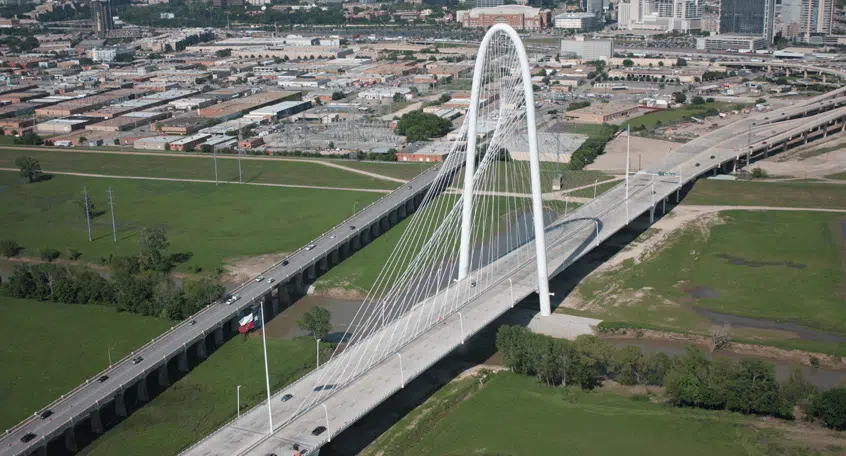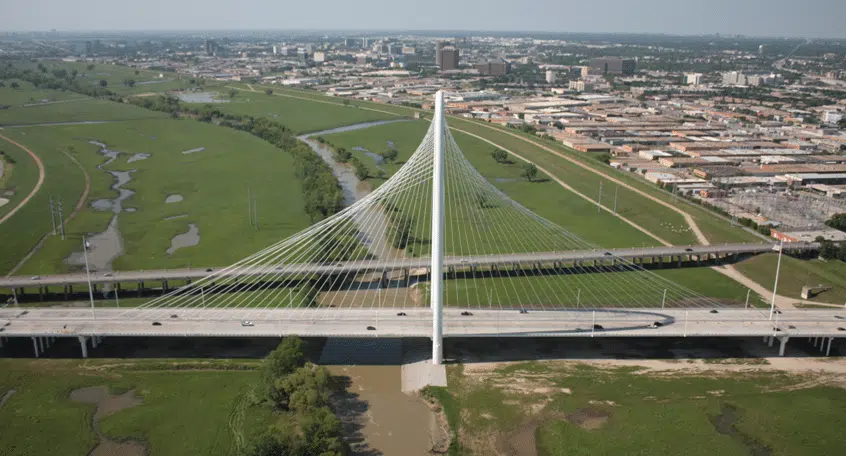Welcome to Williams Brothers Construction Co., Inc.
Margaret Hunt Hill Bridge
Project Details
WB served as the Prime Contractor for this TxDOT $74 million signature cable stayed bridge that crosses the Trinity River west of downtown Dallas and is located on Spur 366 (Woodall Rodgers Freeway). The City of Dallas in conjunction with the US Army Corps of Engineers (USACE) manages and maintains the floodplain at this location.
The signature features of the Margaret Hunt Hill (MHH) Bridge are the center arch pylon soaring to a height of 440 feet above the floodplain, coupled with a unique stay cable arrangement. The construction of the MHH Bridge enhanced mobility and spurred economic development by connecting downtown and West Dallas, resulting in a revitalization in a previously under-developed area. An iconic landmark, the MHH Bridge is a signature part of Dallas’ skyline.
The MHH Bridge incorporated several unique shapes necessitating a team effort of TxDOT and WB personnel, designers, fabricators, erectors and technical experts to address architectural requirements relative to construction tolerances, welding equipment, and procedures, work platforms, stay cable installations and painting.
WB performed 96 drilled shafts for the approach spans with diameters from 84-inches and depths up to 110-feet, with penetration into limestone followed by concrete substructure and superstructure. The steel arch pylon is formed by two inclined tower legs that join at the top and form a parabolic curve. There are 58 stay cables uniformly spaced around the top of the arch pylon and connected along the superstructure centerline below.
The superstructure consists of a steel central (spine) box girder with cantilevered steel transverse floorbeams. The central box girder provides the necessary torsion-al stiffness and bending capacity. Two exterior steel
C-shaped girders provide additional horizontal stiffness to the structural system. Longitudinal steel stringers span between the floorbeams and support the cast-in-place concrete deck.
The approaches to the cable-stayed main span included eight spans of Type U54 beams. WB fabricated the prestressed concrete beams and panels which helped control expenditures, maintain schedule integrity, project cash flow, and retain quality control. Our team relied on a rigorous quality control program to meet the finishes required for the ultimate configuration.
TCEQ closely monitored for compliance with BMPs and stormwater run-off. WB also worked with the USACE and was the first contractor to coordinate construction in the Trinity Basin after Hurricane Katrina. WB is adept at implementing a construction plan that is spatially conscious and contains all appropriate mitigation measures for each project phase. TxDOT approved WB’s recommendation to modify the deck drainage system early in the project, which resulted in $315,000 in cost savings.
The project team successfully engaged residents, businesses, area stakeholders and elected officials during both the design and construction phases, which proved to be critical to overall project success.
WB successfully worked 100,611 man-hours with no lost time accidents.











Project overview
- Project Name: Margaret Hunt Hill Bridge
- Location: Dallas, Texas
- Year Completed: 2001
- Value: $74M
- Category: Bridges